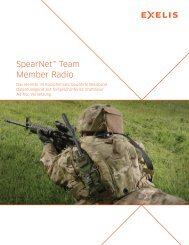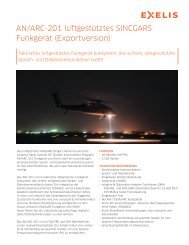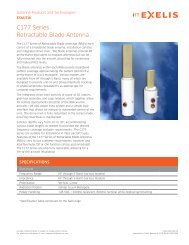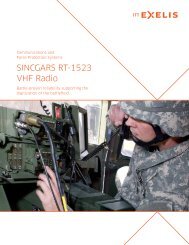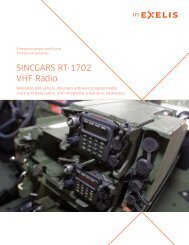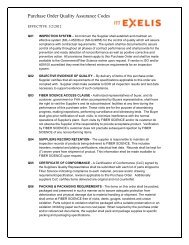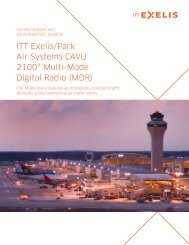Interview with Chris Bernhardt for The Journal of ... - ITT Exelis
Interview with Chris Bernhardt for The Journal of ... - ITT Exelis
Interview with Chris Bernhardt for The Journal of ... - ITT Exelis
Create successful ePaper yourself
Turn your PDF publications into a flip-book with our unique Google optimized e-Paper software.
24<br />
<strong>The</strong> <strong>Journal</strong> <strong>of</strong> Electronic Defense | May 2012<br />
interview<br />
CHRIS BERNHARDT President, <strong>ITT</strong> <strong>Exelis</strong>,<br />
Electronic Systems<br />
By John Knowles<br />
Division<br />
Defense electronics companies,<br />
like <strong>ITT</strong> <strong>Exelis</strong>, are<br />
facing a variety <strong>of</strong> challenges<br />
in terms <strong>of</strong> constrained<br />
defense budgets<br />
in traditional markets,<br />
gaining access to emerging overseas<br />
markets, and developing the technologies<br />
needed <strong>for</strong> competitive EW, radar<br />
and communications solutions to meet<br />
tomorrow’s requirements.<br />
JED recently interviewed <strong>Chris</strong><br />
<strong>Bernhardt</strong>, <strong>Exelis</strong> Executive Vice President<br />
and President <strong>of</strong> the <strong>Exelis</strong> Electronic<br />
Systems division, to get his perspective<br />
on the trends and developments in<br />
the defense electronics market. When<br />
<strong>Bernhardt</strong> joined <strong>ITT</strong> <strong>Exelis</strong> in 2001 as<br />
President <strong>of</strong> its Avionics Systems Division,<br />
the Clifton, NJ, business unit was doing<br />
about $100 million in sales annually.<br />
Leading the business unit through a<br />
decade <strong>of</strong> organic growth, acquisition,<br />
new product development and reorganization,<br />
<strong>Bernhardt</strong> now oversees a trans<strong>for</strong>med<br />
Electronic Systems business that<br />
is a multi-billion dollar enterprise.<br />
JED: How much has the transition to<br />
<strong>ITT</strong> <strong>Exelis</strong> reshaped the Electronic<br />
Systems business <strong>of</strong> the company?<br />
Our business shape itself has not<br />
changed as a result <strong>of</strong> the spin<strong>of</strong>f.<br />
Through acquisitions and internal<br />
restructuring during the past few years,<br />
Electronic Systems was already well positioned<br />
and aligned <strong>with</strong> customer priorities<br />
at the time <strong>of</strong> the spin. For example,<br />
to address the need <strong>for</strong> multi-functional<br />
capabilities and networked solutions,<br />
we combined our Communications and<br />
Force Protection Systems businesses<br />
and divided one <strong>of</strong> our business areas to<br />
create a standalone Airborne Electronic<br />
Attack business. Now, we have five business<br />
areas: integrated electronic warfare<br />
systems, radar, reconnaissance and<br />
acoustic systems, integrated structures,<br />
communications and <strong>for</strong>ce protection<br />
systems, and our airborne electronic<br />
attack business.<br />
What the spin has enabled us to do<br />
is increase our agility and strategically<br />
focus our resources on the defense and<br />
aerospace market. We can be even more<br />
responsive to the needs <strong>of</strong> our customers,<br />
which include all military services,<br />
key large primes, and international<br />
customers in 60 countries. At <strong>Exelis</strong><br />
we have a unified and highly focused<br />
approach to winning and investing in<br />
the marketplace, driven by an operating<br />
culture that values one team, <strong>with</strong> one<br />
mission and one shared future.<br />
JED: Being a relatively small, $100<br />
million business a decade ago, how<br />
does the trans<strong>for</strong>mation to a much<br />
larger, global organization influence<br />
your thinking and your approach to<br />
the market?<br />
We tailor our strategy as global market,<br />
customer, political, and competitive<br />
dynamics dictate. Agility, open teambased<br />
collaboration and speed are critical<br />
to addressing these dynamics. As we<br />
have grown, we have taken a disciplined<br />
approach to reshaping and trans<strong>for</strong>ming<br />
our portfolio <strong>of</strong> solutions, customers,<br />
plat<strong>for</strong>ms and countries, both organically<br />
and through acquisition. We have<br />
a few fundamental strategies that guide<br />
us in reshaping our portfolio. <strong>The</strong> first<br />
is to not lose focus on our core business<br />
areas and our core customers. Second,<br />
we expand our portfolio <strong>of</strong> plat<strong>for</strong>ms,<br />
customers and solutions based on our<br />
core competency model. That is where<br />
we leverage resources generated from<br />
nurturing our core, and focus our IR&D<br />
on solutions that will be enablers <strong>for</strong><br />
our customers. To give you a few examples,<br />
five years ago we were not in synthetic<br />
aperture radar, and we were not<br />
in AESA-type technology. We had only<br />
started thinking about pods as another<br />
option to our internal EW system.<br />
Today, we have customers in all <strong>of</strong> these<br />
areas. I believe that when we understand<br />
where the capability gaps are<br />
<strong>for</strong> our customers, we are able to focus<br />
our IR&D very effectively in providing<br />
You hear the term<br />
“open architecture”<br />
everywhere these days,<br />
yet there are many<br />
layers to it.<br />
af<strong>for</strong>dable best-value solutions. Finally,<br />
<strong>Exelis</strong> Electronic Systems now has an<br />
extremely large installed base that can<br />
serve as an engine <strong>for</strong> upgrades and<br />
growth across the product portfolio.<br />
JED: <strong>The</strong> DOD wants to move toward<br />
modular open system architecture<br />
(MOSA) standards. What does that<br />
mean <strong>for</strong> you and your customers?<br />
You hear the term “open architecture”<br />
everywhere these days, yet there<br />
are many layers to it. From a customer<br />
standpoint, the concept involves a desire<br />
<strong>for</strong> rapid technology upgrades at reduced<br />
costs, which mitigates diminishing manufacturing<br />
sources. <strong>The</strong> DOD sees MOSA<br />
as a way to ensure af<strong>for</strong>dable, functional<br />
upgrades (technology refreshes) over<br />
time. Open architecture provides the<br />
opportunity <strong>for</strong> the Government not to<br />
be locked into unique supplier solutions,<br />
where cost concerns, if not properly mitigated,<br />
could arise. In addition, it can<br />
help <strong>of</strong>fset potential vertical integration<br />
trends by sole source primes <strong>with</strong> unique<br />
“non open” solutions. All <strong>of</strong> these factors
interview | CHRIS BERNHARDT President, <strong>ITT</strong> <strong>Exelis</strong>, Electronic Systems Division<br />
should provide more af<strong>for</strong>dable solutions<br />
<strong>for</strong> our customers.<br />
For <strong>Exelis</strong> Electronic Systems, we are<br />
working <strong>with</strong> our customers to incorporate<br />
open architecture concepts where<br />
they make sense. <strong>The</strong> JCREW I1B1 system<br />
we’re developing is a MOSA design,<br />
as is our IRCM solution and several others<br />
in our classified business.<br />
From the 50,000-foot strategic level,<br />
we will continue to embrace open system<br />
architectures where they add value<br />
<strong>for</strong> the customers we serve. We’ve been<br />
doing it, and we’re going to continue<br />
doing it. I don’t see that changing. At<br />
the same time, pr<strong>of</strong>itability is highly<br />
regulated in our industry, and that<br />
impacts internal research and development<br />
decisions. MOSA-driven requirements<br />
and procurements will impact the<br />
pay<strong>of</strong>f calculation and business model<br />
<strong>for</strong> industry. At the end <strong>of</strong> the day,<br />
the core <strong>of</strong> any MOSA system revolves<br />
around standard interfaces and the<br />
operating system. <strong>The</strong> US Government<br />
wants to own that. <strong>The</strong>y want to own<br />
the s<strong>of</strong>tware, and they want to own the<br />
hardware, too. On JTRS, <strong>for</strong> example, the<br />
business model originally intended <strong>for</strong><br />
the Government to own the wave<strong>for</strong>m<br />
s<strong>of</strong>tware rights, but provided <strong>for</strong> competition<br />
and innovation on the hardware<br />
side. As time has progressed, most<br />
<strong>of</strong> the original <strong>for</strong>m factors have been<br />
eliminated due to poor cost and technical<br />
per<strong>for</strong>mance. <strong>The</strong> Government has<br />
the opportunity to exploit commercially<br />
derived technologies and contractor<br />
investments in low cost, high per<strong>for</strong>mance<br />
radios, but must overcome the<br />
“build-to-print” approach which is not<br />
well suited to modern communication<br />
systems. <strong>The</strong> current approach is highly<br />
regulated, and that can hinder industry<br />
innovation and impact the capabilities<br />
we provide our fighting <strong>for</strong>ces.<br />
Better technical and af<strong>for</strong>dable alternative<br />
solutions exist, but they are not<br />
on a level playing field versus a Program<br />
<strong>of</strong> Record. So how should the DOD acquisition<br />
and requirements process change<br />
in tandem to rapidly support more<br />
af<strong>for</strong>dable, innovative solutions from<br />
the Defense industry? This is where<br />
I think the struggle is going to be <strong>for</strong><br />
industry, in general.<br />
Multifunction systems<br />
are very complex from<br />
a systems design and<br />
s<strong>of</strong>tware perspective<br />
and yield more<br />
sophisticated solutions.<br />
A key challenge to gaining traction<br />
<strong>with</strong> the open architecture model is<br />
the limited number <strong>of</strong> new starts projected<br />
during the next decade. With<br />
the proposed decreases in RD&E and<br />
procurement spending, new starts are<br />
going to be rare events. Programs that<br />
are already in process are going to be<br />
around <strong>for</strong> the next decade assuming<br />
they are per<strong>for</strong>ming well.<br />
Between the lack <strong>of</strong> new starts and<br />
the trade<strong>of</strong>fs not yet fully understood<br />
between open and unique systems, I<br />
believe progress will be slow in this area<br />
and that we will be challenged to create<br />
a uni<strong>for</strong>m open architecture standard<br />
<strong>with</strong>in the next several years. However,<br />
I do think we will make progress on a<br />
plat<strong>for</strong>m basis, and I believe the concepts<br />
inherent in open architecture<br />
– best <strong>of</strong> breed technologies, collaboration<br />
and af<strong>for</strong>dability – will continue to<br />
serve industry well as we develop and<br />
adapt solutions <strong>for</strong> the warfighters <strong>of</strong><br />
today and tomorrow.<br />
JED: In addition to MOSA, the DOD<br />
is also becoming more interested in<br />
multi-function systems. What work<br />
is <strong>ITT</strong> <strong>Exelis</strong> doing in this area?<br />
Multi-functional systems are very<br />
complex from a systems design and<br />
s<strong>of</strong>tware perspective and yield more<br />
sophisticated solutions. One example<br />
is our JCREW I1B1 system <strong>of</strong> systems<br />
which uses a MOSA architecture and is<br />
truly multi-functional. This system has<br />
data exchange capability, and it can<br />
per<strong>for</strong>m over-the-air networked monitoring,<br />
control and reprogramming. It<br />
does more than radio frequency counter<br />
IED in terms <strong>of</strong> its architecture. It<br />
can per<strong>for</strong>m direction finding, and it<br />
can actually get into a network in an<br />
unconventional sense. It is a network<br />
enabler, because all in-view situational<br />
awareness and situation updates can<br />
now be shared through that system.<br />
On the IR side, our IRCM solution was<br />
designed as a multi-function system, as<br />
well. In addition to IR jamming, if you<br />
wanted to do optical communications,<br />
obstacle avoidance or respond to hostile<br />
fire, it was architected to enable<br />
those functions.<br />
But the larger question <strong>for</strong> industry<br />
is how will the customer value this<br />
additional functionality? <strong>The</strong> customer<br />
knows the recurring cost pr<strong>of</strong>ile <strong>of</strong><br />
legacy, fielded single-function systems<br />
very well. <strong>The</strong>se single-function legacy<br />
systems have been bought in high quantities<br />
to support OEF/OIF campaigns<br />
over the last five or so years. <strong>The</strong>se high<br />
volume rates have a dramatic impact<br />
on lowering costs through large learning<br />
curve reductions and supply chain<br />
leverage. I do not believe we will see<br />
these high unit volume rates in the near<br />
future.<br />
So, <strong>for</strong> sake <strong>of</strong> discussion, let’s just<br />
say it costs $1 <strong>for</strong> that legacy highvolume<br />
system. And now our customers<br />
want a multi-function system, which<br />
is designed to provide many times the<br />
functionality <strong>of</strong> predecessor legacy system,<br />
in addition to enabling new, more<br />
effective CONOPS and simplifying reprogramming.<br />
<strong>The</strong>re is a non-recurring<br />
development cost to multi-functionality<br />
that usually has to be borne by the<br />
Program <strong>of</strong> Record, and there is a clear<br />
compelling warfighter and network situational<br />
awareness/update advantage.<br />
Plus, there is efficiency in going multifunctional…<br />
but at what cost? Perhaps<br />
$1.30 or higher?<br />
I believe those <strong>of</strong> us in industry and<br />
our customers need to jointly understand<br />
the total holistic value proposition<br />
that multi-function provides, and<br />
not compare it <strong>with</strong> the single, stovepiped<br />
solutions <strong>of</strong> several years ago.<br />
<strong>The</strong>n we can decide if multi-functional is<br />
what we need. <strong>The</strong>re is neither a simple<br />
nor single right answer to the question<br />
<strong>of</strong> whether/when you need a multifunctional<br />
system. Understanding this, we<br />
will continue collaborating <strong>with</strong> our<br />
customers to ensure we have the right<br />
solution <strong>for</strong> the mission at hand. a<br />
<strong>The</strong> <strong>Journal</strong> <strong>of</strong> Electronic Defense | May 2012 25



